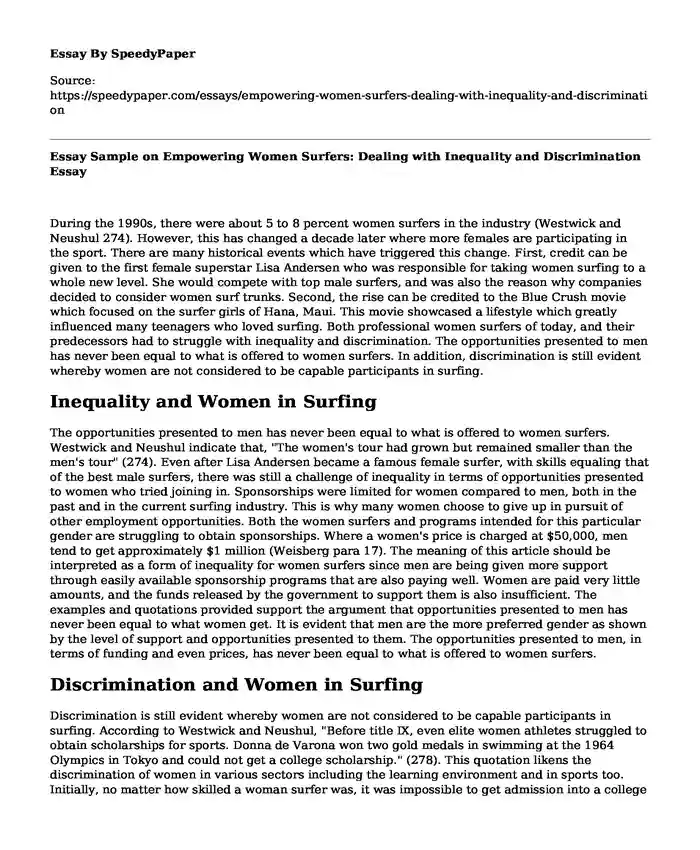
| Type of paper: | Essay |
| Categories: | Women Discrimination Sport Human rights |
| Pages: | 3 |
| Wordcount: | 815 words |
During the 1990s, there were about 5 to 8 percent women surfers in the industry (Westwick and Neushul 274). However, this has changed a decade later where more females are participating in the sport. There are many historical events which have triggered this change. First, credit can be given to the first female superstar Lisa Andersen who was responsible for taking women surfing to a whole new level. She would compete with top male surfers, and was also the reason why companies decided to consider women surf trunks. Second, the rise can be credited to the Blue Crush movie which focused on the surfer girls of Hana, Maui. This movie showcased a lifestyle which greatly influenced many teenagers who loved surfing. Both professional women surfers of today, and their predecessors had to struggle with inequality and discrimination. The opportunities presented to men has never been equal to what is offered to women surfers. In addition, discrimination is still evident whereby women are not considered to be capable participants in surfing.
Inequality and Women in Surfing
The opportunities presented to men has never been equal to what is offered to women surfers. Westwick and Neushul indicate that, "The women's tour had grown but remained smaller than the men's tour" (274). Even after Lisa Andersen became a famous female surfer, with skills equaling that of the best male surfers, there was still a challenge of inequality in terms of opportunities presented to women who tried joining in. Sponsorships were limited for women compared to men, both in the past and in the current surfing industry. This is why many women choose to give up in pursuit of other employment opportunities. Both the women surfers and programs intended for this particular gender are struggling to obtain sponsorships. Where a women's price is charged at $50,000, men tend to get approximately $1 million (Weisberg para 17). The meaning of this article should be interpreted as a form of inequality for women surfers since men are being given more support through easily available sponsorship programs that are also paying well. Women are paid very little amounts, and the funds released by the government to support them is also insufficient. The examples and quotations provided support the argument that opportunities presented to men has never been equal to what women get. It is evident that men are the more preferred gender as shown by the level of support and opportunities presented to them. The opportunities presented to men, in terms of funding and even prices, has never been equal to what is offered to women surfers.
Discrimination and Women in Surfing
Discrimination is still evident whereby women are not considered to be capable participants in surfing. According to Westwick and Neushul, "Before title IX, even elite women athletes struggled to obtain scholarships for sports. Donna de Varona won two gold medals in swimming at the 1964 Olympics in Tokyo and could not get a college scholarship." (278). This quotation likens the discrimination of women in various sectors including the learning environment and in sports too. Initially, no matter how skilled a woman surfer was, it was impossible to get admission into a college since this gender was not considered worthy to be given scholarship. Unfortunately, the gap is yet to be filled completely as discrimination still exists outside of the learning environment. When sponsored, the advertisements tend to focus more on the surfer's body rather than the skills (Roxy 0.16). This advertisement is in itself used as an example of discrimination where women are being reduced to mere objects, even though they have outstanding skills that are comparable to other male pros. It can be interpreted that women do not have the muscle and physical fitness that is required to make them champions. Men, on the other hand, are argued to be strong and masculine and capable to surfing the waves with ease. The quotation and video examples used showcase the discrimination challenge that many women surfers have to overcome every day. Discrimination is still evident whereby women, because of their feminine bodies, are not considered to be capable participants in surfing.
Conclusion
Women surfers have had to struggle with inequality and discrimination for years. Although progress has been made to try and accept this gender into the sport, a lot still needs to be done to ensure equal treatment and support for both genders. The first step that is needed should be based on laws and legislation that will illegalize the discrimination of women and ensure equal treatment and opportunities. Which laws and legislation can be introduced to support women in surfing and ensure equality?
Works Cited
Roxy. "Roxy Pro Biarritz 2013 Official Teaser." Youtube, https://www.youtube.com/watch?v=GCji6TiJjbE
Weisberg, Zach. "For Female Surfers, Challenges Out Of the Water". Nytimes.Com, 2011, https://www.nytimes.com/2011/03/27/sports/27surfing.html. Accessed 21 Jan 2020.
Westwick, Peter and Neushul, Peter. "The World in the Curl: An Unconventional History of Surfing." Crown, 2013, 213-300.
Cite this page
Essay Sample on Empowering Women Surfers: Dealing with Inequality and Discrimination. (2023, Mar 26). Retrieved from https://speedypaper.net/essays/empowering-women-surfers-dealing-with-inequality-and-discrimination
Request Removal
If you are the original author of this essay and no longer wish to have it published on the SpeedyPaper website, please click below to request its removal:
- Free Essay Sample on Pope Urban's Speech at Clermont
- Essay Sample on Company Registration in the UK and Germany
- Essay Example about the Discrimination on the African American in the United States
- International Business: Strategies, Structures & Alliances. Free Essay
- Paper Example - Environmental Analysis for Invision LenseTechnological Trends
- Essay Sample on Political Meaning - The Mule
- Fredrick Douglass and Jefferson on Slavery. Paper Example
Popular categories




